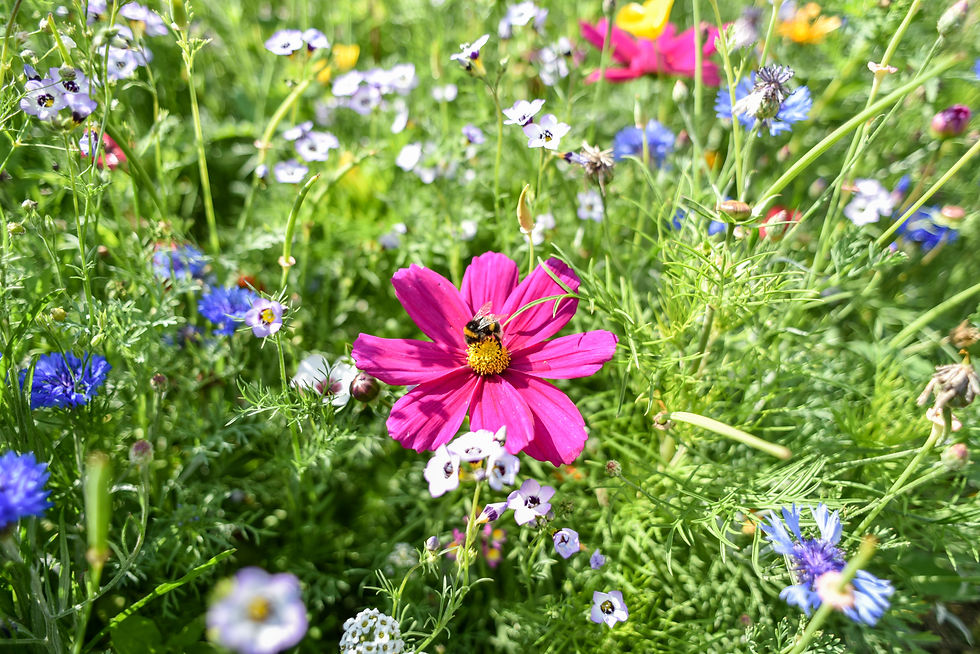How to Create a DIY Bug Hotel for Your Garden: A Step-by-Step Guide
- All Thing's ACS
- Mar 28
- 3 min read
Creating a bug hotel is not only fun but also an impactful way to enhance your garden and support local wildlife. By creating a cosy home for beneficial insects like ladybugs, bees, and butterflies, you can boost pollination and pest control in your garden.
Let’s dive into how you can build your own bug hotel and make a positive difference in your ecosystem.
Why Build a Bug Hotel?
Bug hotels serve as vital shelters for helpful insects. For example, bees are responsible for pollinating approximately 75% of our food crops. Supporting these little allies can lead to a healthier garden, with vibrant flowers and abundant vegetables. Observing these insects can be a joy for people of all ages.
Materials You'll Need
Before you start building, gather the following materials:
Wooden pallets or any untreated wood: These will form the main structure of your hotel.
Natural fillers: Twigs, straw, leaves, bamboo sticks, and pine cones will attract various species.
Fasteners: Nails or screws to assemble the structure.
Tools: A hammer or a drill for construction.
Optional: Landscape fabric to keep the interior dry.
Always choose untreated materials to protect the insects.
Choosing the Right Location
The location of your bug hotel can have a significant impact. Select a spot that is sheltered from harsh winds and receives plenty of sunlight. Ideally, position it near flowering plants, like lavender or sunflowers, to provide food. Elevating the hotel on a wooden post or platform can help keep pests like slugs away.
Constructing the Bug Hotel
Step 1: Build the Frame
Use wooden pallets or any untreated wood to construct a frame. Secure the frame tightly with nails or screws to ensure it stands up against the elements and supports the weight of the filler materials. There is no right or wrong bug hotel size so make it to suit your chosen space.
Step 2: Create Chambers
Divide the interior using horizontal boards or wooden dividers to create multiple chambers. Each chamber can host different natural materials, allowing a variety of species to thrive. For instance, consider dedicating one chamber for twigs and another for pine cones.
Step 3: Fill the Chambers
Now, let’s fill the chambers! Here are some recommended materials:
Sticks and twigs: Ideal for solitary bees to nest.
Straw: Attracts lacewings and ladybugs.
Pine cones: Provide a cosy spot for beetles.
Bamboo sticks: Cut to different lengths to host varying insect species.
Aim for a balance of solid and hollow spaces, as different insects have unique preferences.
Step 4: Add a Roof
To protect your bug hotel from rain and moisture, add a slanted roof using timber or a waterproof material. This will help keep the inside cosy and dry, which is essential for the insects' survival.
Step 5: Decorate (Optional)
Feel free to get creative! You can use non-toxic paint to brighten it up or add natural decorations. Bright colours can help attract insects, adding extra benefits to your bug hotel.
Encouraging Inhabitants
After building your bug hotel, it might take a while for it to attract residents. Consider these tips to encourage insects to move in:
Plant native flowers nearby: Native plants are known to attract beneficial insects. For example, planting echinacea or bee balm can significantly increase visits from pollinators.
Avoid pesticides: Chemicals can deter insects. Instead, opt for natural alternatives.
Provide water sources: A small dish of water filled with pebbles can serve as a watering hole, inviting more wildlife to your garden.
Maintenance Tips
Regular maintenance of your bug hotel ensures it remains a welcoming habitat. Here are key tips:
Check for blockages: Regularly remove debris from the chambers for easy insect access.
Replace materials as needed: Natural materials can degrade over time. Refresh them to keep your hotel inviting.
Monitor for pests: Keep an eye on potential unwelcome guests.
Building a Vital Habitat for Insects
Creating your DIY bug hotel is a fulfilling task that greatly benefits your garden and local ecosystems. By following these steps, you're providing a safe space for beneficial insects, which are integral to a thriving garden.
Although it may take some time for the hotel to fill up, your patience will be rewarded with a lively community of insects actively contributing to your garden. Involving yourself in this meaningful project fosters biodiversity while allowing you to enjoy the beauty of nature from the comfort of your own garden.
Happy gardening!




Comentarios